
One of the pioneers in the world of samba for female artists, Dona Ivone Lara began composing since she was a kid, at just 12 years old. Misogyny, however, meant that decades would pass before the artist was recognized for her creations. A member of the “Prazer da Serrinha” samba school, she knew that her compositions would not be accepted if others knew that they had been written by a woman. That’s why his cousin Mestre Fuleiro presented them as if they were written by himself. With the great acceptance to the songs, Ivone secretly had confirmation that she was good at what she did.
Let’s travel to 1999, when she performed two shows at Sesc Vila Mariana, on the 3rd and 4th of September 1999. At 77 years old, now respected as the “Great Lady of Samba”, Lara sang a handful of classics of her own (most with lyrics by Delcio Carvalho, her most frequent partner), enchanting the audience with her interpretations (the tuned voice of someone who was part of a choir conducted by Villa-Lobos) and its inspired melodies. One of those nights was immortalized in the recording that now reaches the audience on the album Relicário: Dona Ivone Lara (live at Sesc 1999), the fifth work of the Selo Sesc project, which is published exclusively by Sesc Digital.
Being on stage was one of her greatest joys: no wonder, the sambista1 only stopped performing at a very advanced age, after 90 years old. His last musical record was a participation on the DVD and CD Sambabook Dona Ivone Lara, which paid homage to her work and was recorded live in November 2014, in Rio de Janeiro, when the artist was 92. “What I like to do most is to perform in a stage. It is thew thing that I love most. I fell myself fulfilled when I’m in a theater, on a stage. I don’t need to earn a lot, but if I’m singing and seeing people along with me, singing too, oh, I’m fulfilled”, said the artist, in an interview with the TVE special program “Eu sou o show”, in 1985.
The repertoire of the show presented at Sesc was based on the album Bodas de Ouro, from 1997, which celebrated the 50-year career of one of the biggest names in samba, bringing 13 re-recordings of hits from her career. Twelve of them featured special appearances, from renowned names, such as Gilberto Gil, Martinho da Vila, Djavan, Danilo Caymmi, Beth Carvalho, and Almir Guineto, to artists who, at the time, were in the spotlight, such as Netinho (from Negritude Jr), Ara Ketu and Adryana Ribeiro (from the group Adryana e a Rapaziada).
“It wasn’t the album she wanted to make, by the way. The record label imposed the repertoire and the guests — without recording for many years (like other sambistas, Dona Ivone lost her place to the “boutique pagode”2), she said yes. The outcome is good, but it could be better if it presented new features from one of the most brilliant melodists in Brazilian music scenario”, said journalist Mauro Dias in an article in newspaper Estado de S. Paulo announcing the shows at Sesc.
The milestone for the celebration album was Dona Ivone Lara’s entry into the recently founded Rio’s samba school “Império Serrano”, in 1947, which the artist was part of for decades. In the same year, she signed the samba “Não Me Perguntes”, considered an anthem of the group. But it was only in 1965 that she would join the composers wing3 of the samba school “Verde e Branca”, writing the samba-enredo4 “Os cinco bailes tradicionais da história do Rio”, composed in partnership with Silas de Oliveira e Bacalhau — the first created by a woman to be in a Carnival parade of a large samba school. With this theme, Império samba school was runner-up in Carnival contest. Although there is news of composers before Dona Ivone in the samba universe, none had achieved such prestige. To date, none have achieved as much, and she stands out not only among women in the genre, but among artists in general.
Despite his unequivocal talent and his grounded and diverse musical training, a combination of misogyny and racism was decisive for everything in his career to happen slowly — stepping devagarinho (slowly), as one of his famous compositions says. The time it took to take each step in his artistic life — she composed her first song at age 12 and released her first solo album only at 56 — is an example of the many obstacles faced by black artists, especially women, in Brazil. It is no coincidence that many sambistas ended their lives in poverty. Ivone only began to dedicate herself completely to music in 1977, after retiring from her work as a nurse and social worker, a career that guaranteed her financial stability and in which she also stood out, having worked with the renowned psychiatrist Nise da Silveira.
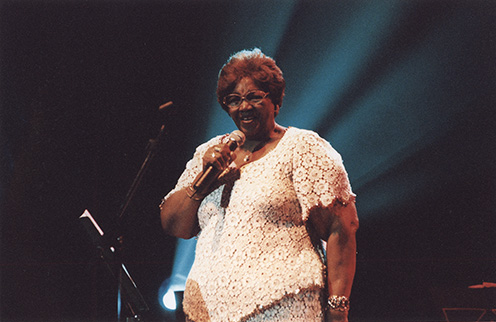
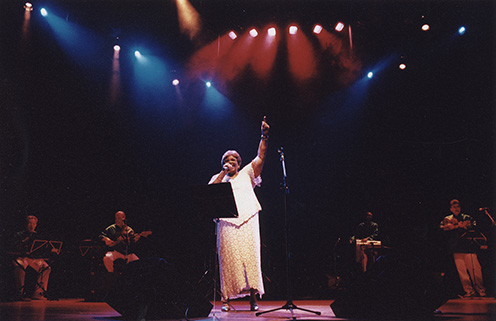
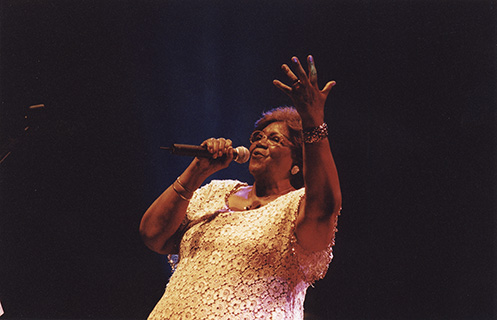
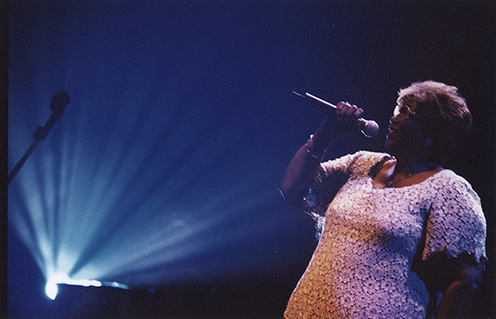
“Since I was a child, I was crazy about being an artist. One of my aunties was full of prejudice, she thought artists were no good. She raised me and never let me get involved with artists. But everything I wanted to do in life I did. So, I waited 37 years for retirement and did what I wanted to do: be an artist, record my songs, sing on the radio and television”, said Dona Ivone Lara in an interview with Antônio Chrysostomo, in the article “Um novo LP. Uma turnê a Paris: Dona Ivone Lara, compondo e cantando à beira do fogão” (A new LP. A tour to Paris: Dona Ivone Lara, composing and singing by the stove), published in the newspaper “O Globo”, in October 1979.
Although it took a while to release her debut album (it was only in 1978 that Samba minha verdade, samba minha raiz), since 1970, the future “Queen of Samba” had been recording songs released in compilations that featured new artists — the first of which was Sargentelli e o Sambão (1970), produced by Oswaldo Sargentelli and Adelzon Alves. It was they who gave her the name “Dona Ivone Lara”, a stage name she adopted reluctantly, because of the duo’s persistence; after all, she wasn’t even 50 years old yet.
Her talent as a songwriter soon attracted attention, and many of her songs were first recorded by other singers. This was the case of “Liberdade” (partnership with Délcio Carvalho), which opened the Sesc Vila Mariana presentation, released by Roberto Ribeiro on the album Poeira pura, 1977. The lyrics speak of the nostalgia of a lost love, as does the following song, “Tendência” (her song with Jorge Aragão), a classic song presented in rodas de samba5 and one of the jewels of the artist’s work. The song was released by her in the album Sorriso Negro (1981) (Black Smile).
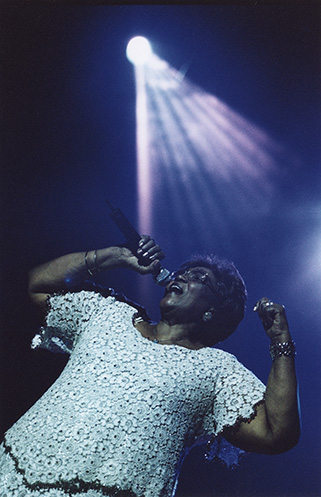
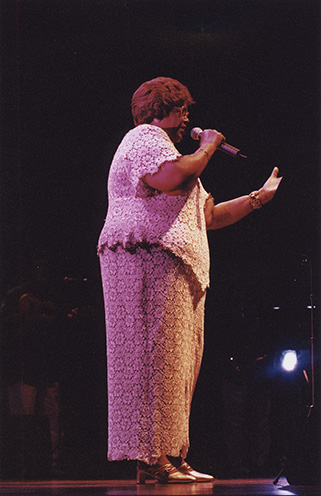
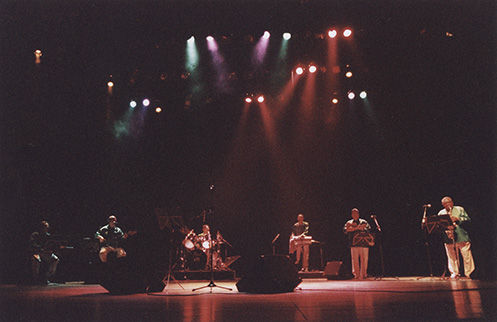
Although the character’s gender is not mentioned, when the song is performed by Aragão, it seems to maintain a tradition of this musical style, evoking the figure of the evil woman, who “destroyed what was hers”. Under Ivone Lara’s voice, the impression is that the roles are reversed, being a cruel man, a position that is rarely occupied by a man in Brazilian music, since the majority of the Brazilians composers were (and still are) male. With the current questions about heteronormativity, it is still possible to play with imagining other possibilities for the character of the lyric.
The sequence features “Sorriso de Criança” (with Délcio Carvalho), a track that gives its name to the singer’s second album, from 1979. Although less frequently, Ivone Lara also wrote lyrics, and one of them was “Samba de Roda Pra Salvador”, which she wrote by herself. The song was recorded in Alegria minha gente (Serra dos Meus Sonhos Dourados), from 1982, and is yet another example of the composer’s versatility, who, in this occasion, focuses on the musical genre of Bahia, a Brazilian state.
She adds two pearls from her repertoire: “Enredo do meu samba” (partnership with Jorge Aragão) which draws an inspired parallel with the universe of samba schools to talk about a love that came to an end, launched in 1984 by Sandra de Sá, on the track of the soap opera named Partido Alto, from Globo, and by Fundo de Quintal, on the album Partido Alto com Partido em 6 e Grupo Fundo de Quintal, and “Mas quem disse que eu te esqueço” (with Hermínio Bello de Carvalho), which had its first records made by Nana Caymmi, on the album …E a gente nem deu nome (1981), and Paulinho da Viola, in Prisma Luminoso (1983).
Wearing a white lace blouse and skirt, Dona Ivone Lara was accompanied by Armando Martinez (keyboard), Edson Bastos (double bass), Gilberto Torgano (drums), Álvaro Barcelos (percussion), Maurício Verde (cavaquinho) and Hélcio Brenha (sax and clarinet). Before the following presentation, the seventh of the night, addresses the Sesc Vila Mariana audience in an “economical” way: “Well, this samba that I’m going to present now is on Zeca Pagodinho’s LP, ‘Pra afastar a solidão’”, she says, about the romantic composition signed by her and Délcio Carvalho, released in 1998 on the album which have the name of the sambista.
The eighth track is a potpourri with “O caminho é meu” (Paulinho Mocidade and Jurandir Bringela, one of the only ones in the show’s repertoire that was not composed by the artist, recorded by her on the album Ivone Lara, from 1985), “Nos Combates Desta Vida” (another partnership with Délcio Carvalho, a kind of hymn about Ivone Lara herself) and “Sereia Guiomar” (also with Délcio Carvalho), recorded by the author with the participation of Bethânia on the album Sorriso Negro (1980).
Next, it’s time for “Resignação” (Dona Ivone Lara with her cousin Hélio dos Santos, Tio Hélio). While listening the song, one imagines that the performer is referring to a man: “Sinto que eu estou me atormentando / E aos poucos me acabando / Por te amar em vão”6, she begins. Near the end, however, she sings from a male point of view, revealing that, once again, the speaker is a man who accuses a woman of making him suffer. “Alimentei uma ilusão / Dentro do meu coração / E hoje vivo tristonho / com resignação”7.
She returns to samba de roda in “Candeeiro da vovó” (with Délcio Carvalho), while the lyrics evoke black Catholic religiosity. After the applause in the song, Dona Ivone says: “Grandma would like to thank you all” and adds another potpourri, which brings together the classics “Acreditar” (with Délcio Carvalho), “Sonho Meu” (with Délcio Carvalho), “Alguém Me Avisou” (with lyrics and melody by Ivone Lara) and “Tiê” (with cousins Tio Hélio and Mestre Fuleiro).
The first two were also recorded by other artists before the composer herself: “Acreditar” was recorded by Roberto Ribeiro (in Arrasta Povo, from 1976) and “Sonho meu” was performed by Maria Bethânia, in a duet with Gal Costa, on the album Álibi (1978). It was Dona Ivone Lara’s first hit: the album in question was the first by a woman to reach one million copies sold. In the same year, the sambista released her praised debut album, Samba minha verdade, samba minha raiz, and the popularity of the song — which, above all, became a kind of Amnesty anthem, thanks to the lines “Sonho meu, sonho meu / vai buscar quem mora longe”8 — gave a nice boost to his career.
“Alguém me avisou” is another song inspired by the Great Lady of Samba. The lines “alguém me avisou / para pisar nesse chão devagarinho”9 seem to describe the artist’s own trajectory. The song was also recorded by Maria Bethânia, alongside Caetano Veloso and Gilberto Gil, on the album Talismã (1980), just over a year after “Sonho meu” was released. The author herself only recorded the song the following year, in Sorisso negro (1981). “Tiê” was one of the first compositions by little Yvonne Lara da Costa. The girl, who was 12 years old, received a bird (Brazilian tanager)10 from her cousins Fuleiro and Hélio, who wrote the song with her.
“All verses I wrote were for the bird. He was my doll, he was my distraction, he was everything to me. So, I talked to this little bird, I petted it, and I wrote all my little verses dedicated to it,” the artist told TVE in 1985. The song was released by her in 1974, on the collective album Quem Samba fica? Fica, creation of Adelzon Alves, with arrangements by João Donato and Maestro Gaya.
She adds a partido-alto11 song “Pagode de Pai Joaquim” (with Délcio Carvalho), released in 1987 by Dominguinhos do Estácio on the album Além de Mim, which would only be recorded by Ivone herself on a disc in the series A música deste século por seus intérpretes, by Sesc SP, in 2003 — the recording was taken from the artist’s participation in the program Ensaio, directed by Fernando Faro on TV Cultura in São Paulo, on February 11, 2002. At the end of the song, after being applauded, she once again addresses to the Sesc Vila Mariana audience: “Thank you very much. But don’t forget that I’m already a grandma, huh? Yeah, you guys have to spare me, okay? Yes, I can’t handle. Otherwise, you know…”, she says, making those present laugh.
“Axé de Ianga (Pai Maior)”, another that she wrote alone, is an example of the presence of religious syncretism in the author’s work: at the same time that she says that the character in the song “rezou a ladainha pra Jesus de Nazaré”12, she narrates that grandpa “tirava irmão do tronco / escondido do senhor / pra curar seus ferimentos / com o banho de abô”13, “abô bath” refers to the mixture of water, macerated herbs and other ingredients used in Candomblé as a bath or to be drunk, called “abô” or “àgbo”.
At the end of the show, Dona Ivone Lara is massive applauded, to which she responds: “Wishing you all much happiness, much aqüé [a word of probable origin in West Africa that means “money” and was very popularized by pajubá, a dialect of the LGBTQIA+ community based on a diversity of African languages initially used in Candomblé “terreiros”14], that without money nothing can be resolved. There are a lot of people out there who say: ‘Money isn’t everything.’ Yes, it is. Without money we don’t do anything! How can you say that money isn’t everything? So, I want you all a lot of happiness, a lot of money in your pocket, a lot of joy, a lot of health and I’d like to ask you to wish the same to me, right? Thank you very much (laughs)”, she has fun, receiving an ovation.
Before what seems to be the last song in the “standard time” repertoire, Dona Ivone once again addresses the audience: “I’m going to leave, will you excuse me?” Then, she sings the emblematic “Aquarela Brasileira” (by her musical partner Silas de Oliveira), the “samba-enredo” by Império Serrano samba school in 1965 — among 20 songs (after all, two of the 15 tracks are potpourris), this is the second not composed by the “Great Lady of Samba” to be part of the show. At that time, the samba school finished the contest in fourth place, but in 1975 the music became a huge success into a recording by Martinho da Vila, on the album Maravilha de cenário. The band ends with an excerpt from “Aquarela do Brasil”, the classic and international hit by Ary Barroso that inspired Silas de Oliveira to compose his ode to Brazil.
In what was probably the encore of the night, of the audience scream “gorgeous” when Dona Ivone Lara sings the first verses of the combative “Sorriso Negro”, by Jorge Portela, Adilson Barbado and Jair Carvalho, released by her in 1981 on the album with the same name, recording with the participation of Jorge Ben Jor. It is the third song by other composers sung in the show by this artist who was one of the biggest names in samba and passed away in 2018, at the age of 97, leaving a precious legacy of resistance and splendor.
Kamille Viola is a journalist and music researcher. Author of the book “África Brasil: um dia Jorge Ben voou para toda a gente ver”, released by Edições Sesc.
About Relicário: Dona Ivone Lara (Ao vivo no Sesc 1999), you may also read:
Utilizamos cookies essenciais para personalizar e aprimorar sua experiência neste site. Ao continuar navegando você concorda com estas condições, detalhadas na nossa Política de Cookies de acordo com a nossa Política de Privacidade.